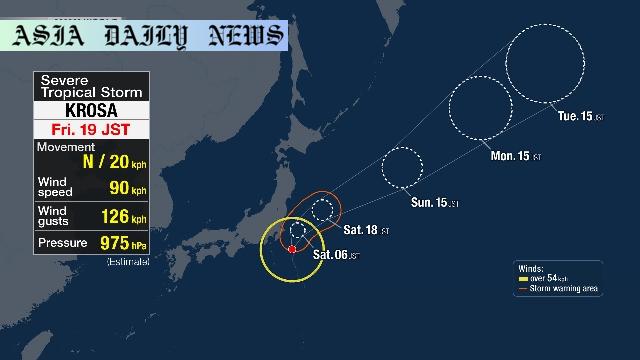Tropical Storm Krosa threatens Japan with heavy rain and gusty winds, urging vigilance for mudslides, flooding, and high waves.
Tropical Storm Krosa is nearing Japan’s Kanto and Tohoku regions.
Heavy rain of up to 120mm and strong winds are expected.
Public alerts issued for mudslides, flooding, and high waves.

Tropical Storm Krosa: A Serious Threat to Coastal Japan
Severe Tropical Storm Krosa is on its way to impacting Japan, posing significant risks to the Kanto region, including the bustling city of Tokyo. The Japan Meteorological Agency (JMA) has issued warnings regarding the severe weather conditions expected to come with the storm. Krosa, which was last tracked east of Hachijojima Island as of Friday evening, is steadily advancing north at a speed of 15 kilometers per hour.
Officials predict that Krosa will bring heavy downpours and gusty winds to the Kanto and Tohoku regions. The Pacific side of the Tohoku region may experience up to 120 millimeters of rain by Saturday evening, while Kanto could see rainfall reaching up to 100 millimeters. Such weather systems, especially with high rainfall intensity, elevate the risks of mudslides, flooding in low-lying areas, and swelling rivers. Waves along the coastlines are also anticipated to rise significantly.
Why Tropical Storm Krosa Demands Public Vigilance
Given the geographical nature of Japan, heavy rainfall often equates to heightened vulnerability to natural disasters. Past experiences have taught the country the importance of preparedness, particularly during typhoon season. Residents of Kanto and Tohoku have been urged to prepare their homes and emergency kits for possible power outages and evacuation scenarios. Authorities are also asking the public to exercise caution when traveling or commuting, as conditions are likely to deteriorate rapidly.
The ongoing projection of Krosa raises concern about potential transportation disruptions, especially in urban areas where flooding can halt train services and block major roadways. Furthermore, the coastal regions are likely to experience high waves, making fishing and marine transport dangerous. The national meteorological agency continues to closely monitor the storm’s trajectory, updating the public as new information becomes available.
The Broader Impact on Communities and Infrastructure
Storms like Krosa serve as reminders of how vulnerable communities can be to extreme weather events in a changing climate. Urban infrastructure, particularly drainage systems, is often overwhelmed by sudden and heavy rainfall. This can lead to the inundation of roads, homes, and critical facilities. Rural areas, on the other hand, face the dual threats of landslides and isolation due to blocked roadways.
In recent years, Japan has invested heavily in mitigation measures, including improved warning systems and training for disaster response teams. While these efforts significantly reduce loss of life, the economic toll of such natural events can still be staggering. Small businesses, farmers, and tourism-dependent areas bear the brunt of the storm’s impact, even if the immediate threat passes quickly.
Precautions and Safety: Staying Ahead of the Storm
As Severe Tropical Storm Krosa continues its approach, staying informed is the best way to ensure safety. Residents are advised to keep a close watch on updates from the Japan Meteorological Agency and local governments. Non-perishable food, clean water, flashlights, and batteries should be stockpiled in advance. Evacuation routes need to be identified, and community shelters should be on residents’ radar in case the situation worsens.
When venturing outdoors, individuals must be extremely cautious due to high risks of falling debris, slippery roads, and impaired visibility caused by heavy rainfall. Furthermore, those living in coastal or mountainous areas should heed evacuation advisories promptly to mitigate risks posed by rising tides or sudden landslides. Safety remains a collective responsibility during such events, and cooperation between citizens and authorities is paramount.



Commentary
Understanding the Role of Preparedness in Crisis Management
Tropical Storm Krosa is yet another reminder of the critical importance of preparedness in the face of natural disasters. Living in a region like Japan, which is highly susceptible to typhoons, earthquakes, and other extreme weather conditions, necessitates a culture of vigilance and readiness. The government and local agencies consistently invest in systems that mitigate the effects of these events; however, individual preparedness plays an equally vital role in ensuring safety and reducing panic during emergencies.
The Unseen Challenges During Storms
While the immediate threats of heavy rain, gusty winds, and storm surges often make headlines, the indirect consequences are just as concerning. Disruption to daily life, such as power outages, halted transportation, and damaged properties, can leave long-lasting psychological and economic scars. Children, the elderly, and other vulnerable populations often face heightened risks during storms. Communities need to come together to create support systems that cater to these individuals’ specific needs.
A Call for Global Awareness and Action
As we examine the impacts of Tropical Storm Krosa, it is clear that climate change exacerbates the severity and frequency of such events. Rising ocean temperatures and shifting weather patterns contribute to storms becoming more intense over time. This calls for not just national efforts, but global participation in reducing carbon footprints and building resilient ecosystems that can withstand such pressures. Respecting the power of nature while taking proactive measures to combat climate change will benefit everyone in the long run.